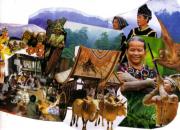Dream and the Confluence of Buddhist and
Shamanic Themes
In Tibetan
literature, as Young has shown, dream narrative proliferated far beyond the
Indian Buddhist. Dreams related to mythic themes of conception and Awakening continued to appear, but compared with the grand
mythic dreams of buddhas and bodhisattvas recorded in Mahayana texts, Tibetan
biographies and autobiographies give the impression of recording real-life
struggles of spiritual aspirants as they learn to distinguish truth from
deception, mundane from supramundane, in their path to liberation.
Concern with dream is the hallmark of a Tibetan
Buddhist spiritual career.
The contradiction
posed by juxtaposing dream as illusion and dream as effective prophecy in
Indian Buddhism a primarily philosophic. It represents the classic split
between the world-affirming ritual-based Brahmanic
religion and world-denying philosophies of the renouncer traditions. The
contrasting views already present in Indian Buddhism, become, however, further
compounded in the Tibetan context by tensions based on the practical function
of dream as a vehicle of spiritual authentification
and path to enlightenment. As has been shown, dream authenticates equally the
shaman and the Buddhist lama. In the Tibetan context, dream further becomes a
practical method of attaining the highest goal of liberation, yet while the
shaman stands confident in the reality and efficacy of his dreams, the lama,
must maintain the philosophic view in which dream signifies delusion,
incompleteness, and lack of perfection. One could say that the Buddhist
spiritual practitioner is authenticated by lies and confusion; the wisdom of
the Buddhist sage is attained by means of the same illusions that keep one
bound to ignorance. This paradoxical situation is, nevertheless solidly based
in Buddhist philosophy which claims that the seed of the destruction of
suffering lies within suffering itself and not without.
In Tibetan culture,
normative Buddhist tantric/yogic, and shamanic strands have merged into a
single continuum that constitutes Tibet's unique religious synthesis. With regard to dream this study has shown that the formation
of such a continuum has reinforced the existing tensions between the ultimate
and relative status of dreams as well as created new ones. Such tensions are
necessary to delineate important differences that would otherwise be lost,
differences that maintain the balance and integrity of the constitutive,
strands. Forces of resolution, however, must also be present because without
them the continuum cannot hold. In their encounter with Buddhism Tibetans found
a tradition whose philosophic emphasis on the interdependency and
interconnectedness of all phenomena allowed the practical shamanic art of
interpreting dream signs and of actively working in and with dream to flourish.
In turn, this efflorescence of dream interest within Buddhism combined with the
tantric and shamanic emphasis on ritual contributed to the development of a
distinctively Tibetan visionary soteriology captured in the words of the
mistress of dream yoga, the yogini Niguma:
When we meditate upon
the illusion-like nature
Of all the illusion-like phenomena,
We attain illusion-like Buddhahood.”
This three part article could also be titled "dream
shamanism" and demonstrated that dream is not only a vehicle and sign of
the shamanic call, but an integral aspect of the shaman’s activity, a form of shamanizing. Further, in the specific case of Tibet, this
contribution contributed to the understanding of Tibetan attitudes to dream and
the Buddhist/shamanic dynamic that underlies those attitudes.
But although there
are a number of works explaining the Tibetam ritual practice of dream yoga, as in-depth history
and specific influences have yet to be traced. Another area encompasses the
whole question of the relationship between shamanism and soteriology. And this
will be the starting point for the research undertaken by us during our
upcoming visit in Tibet and Kashmir during December
2004.
go back to the Shamanism Central Page:

For updates
click homepage here